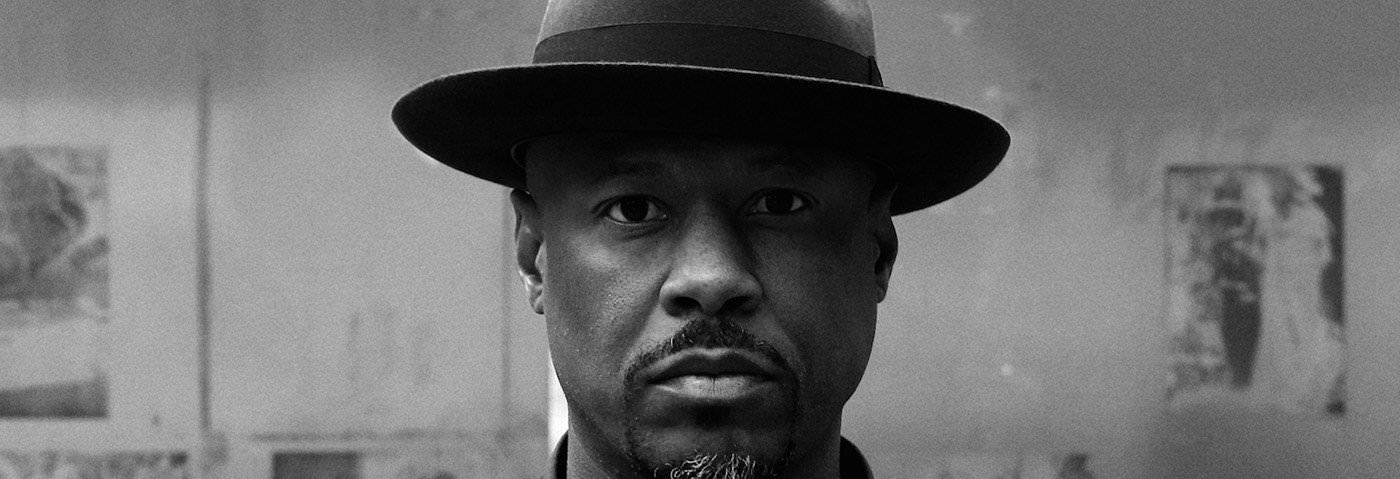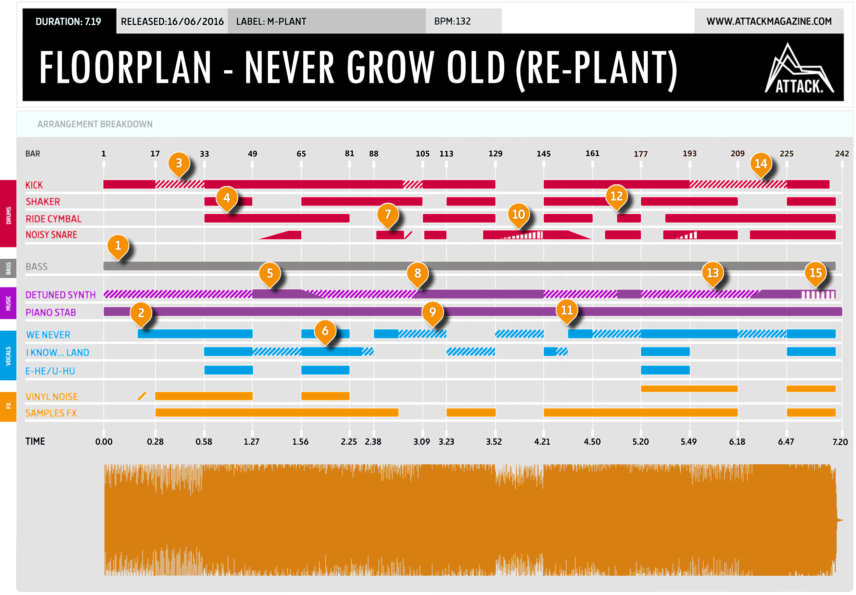In the Deconstructed series, we analyse the arrangements of tracks to see what we can learn from their structure.
In this month’s instalment, we deconstruct Robert Hood alter-ego Floorplan’s ‘Never Grow Old (Re-Plant)’, a gospel-tinged stomper released in its original form in 2013 then as the tweaked ‘Re-Plant’ version the following year.
The Track
The Arrangement
(Click to enlarge.)
what’s happening?
- The re-edited version of ‘Never Grow Old’ opens with all guns blazing. Hood includes the kick, bassline and rhythmic minor chords from the start to ensure that you are engaged instantly. The chords are low-pass filtered and an 8th-note dotted delay is applied to make them sit with the subtle but grooving bassline. Another piano chord is added to address the repetitiveness and add some unpredictability.
- The “we never” vocal that comes in just before the end of the 13th bar is sampled from Aretha Franklin’s ‘We Never Grow Old‘. The vocal lures you towards a build-up and addition of other vocals which sit around each other in a canon pattern.
- The kick is filtered to increase tension prior to the drop and allow the vocals to become the main focus. Simultaneously, a crackly vinyl noise is added, which supports the vintage-sounding vocal samples and glues them to the rest of the track effortlessly. The vinyl noise also does a good job at filling in a bit of frequency space.
- At the drop, the kick comes back in at full force with the addition of cleverly panned hi-hats and cymbals, which add much needed movement to the stereo image. The vocals continue in the same format as before with the odd variation. A ride cymbal becomes the dominant percussive sound and drives the high-frequency energy of the track as well as increasing the variation.
- Hood also finds this a fitting time to start automating the ongoing detuned synth. By opening and closing the filter, he creates a euphoric rise which then descends into a more relaxed vibe. A snare roll supports this up to bar 65, pushing the rise alongside the ride cymbals.
- At bar 65, the track cuts back into a more minimal feeling, in which the vocals become the main focus again. We can hear and feel the return of the vinyl noise, which is a key player in more stripped-back parts of the track. The main detuned synth has also returned to a more mellow sound because of the cutoff being brought back down, filtering away the high frequencies.
- At bar 81, the vocal changes to a single phrase, dropping the energy a little further before introducing a new snare rhythm. At 88, another low cut is applied to the kick, anticipating yet another drop.
- The filter on the detuned synth is opened up, giving a hands-in-the-air moment before the return of the full kick, ride cymbal and what sounds like a shaker.
- The vocal also explodes into a huge ad lib solo with gives a feeling of release. The section continues by losing the ride cymbal and reintroducing a repetitive vocal to help drive the rhythm, followed by the noisy snare.
- The track totally unchains itself and disperses from its key elements at bar 129, letting the listener know that this is the final reprise. The noisy snare, which has a stereo delay, takes the lead in this section by almost doubling in volume and intensity.
- At bar 145 the reprise is met with the same initial minimal drop that we had at 33, using the same simple plus wittily panned hats that keep the head bopping from side to side. As ever, the vocal is changing and continues to be fickle throughout each section, which makes it almost impossible to sing along to. Despite there being relatively few elements, this unpredictable programming keeps the track interesting throughout.
- The ride cymbal – a key and dominant feature in the drums – makes a cameo appearance for the final push, in combination with the vocal giving its hardest and most soulful ad lib.
- Once again, the filter on the synth is automated, adding even more movement and interest.
- We then come back to the repetitive “I know the land” and noisy snare, gracefully leading us to the end of the track. Even the kick seems to lose some energy in the high end.
- Hood comes back with one last attack, an assault with the ride cymbal and change in filter on the detuned synth, before quickly drawing the track to an uncomplicated close after seven breathless minutes.


07.54 PM
play it in a warm-up, play it at 3 in the night or play it in the early morning, play it in a house set, play it in a hot and warm underground techno set… fits it all.
08.41 PM
thanks for this breakdown! Robert Hood’s stripped-down Detroit beats and Aretha’s voice are a match made in heaven. This song proves the cultural timelessness of both genres: gospel and techno
02.33 PM
hey i’d love to know how to make that synth sound ? any tip would be great
edit : ok it just sounds like a triangle wave